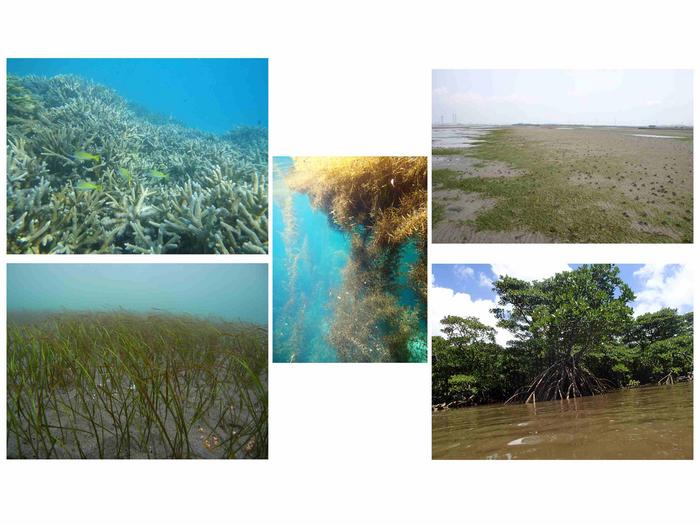A new study of shallow-water ecosystems estimates that, by 2100, climate change and coastal land usage could result in significant shrinkage of coral habitats, tidal marshes, and mangroves, while macroalgal beds remain stable and seagrass meadows potentially expand. Hirotada Moki of the Port and Airport Research Institute, Japan, and colleagues present their findings in the open-access journal PLOS Climate.

Credit: Moki et al., 2023, PLOS Climate, CC-BY 4.0 (https://creativecommons.org/licenses/by/4.0/)
A new study of shallow-water ecosystems estimates that, by 2100, climate change and coastal land usage could result in significant shrinkage of coral habitats, tidal marshes, and mangroves, while macroalgal beds remain stable and seagrass meadows potentially expand. Hirotada Moki of the Port and Airport Research Institute, Japan, and colleagues present their findings in the open-access journal PLOS Climate.
Shallow-water ecosystems absorb a significant amount of carbon dioxide and are therefore expected to help mitigate climate change. Meanwhile, these ecosystems themselves will likely be affected by climate change, including warming seawater. However, it has been unclear exactly how climate change might impact the future size of shallow-water ecosystems.
To help clarify their fate, Moki and colleagues estimated future changes in the total area occupied by the five shallow-water ecosystems thought to be most important: seagrass meadows, macroalgal beds, tidal marshes, mangroves, and coral habitats.
They combined data on the ecosystems’ current sizes and distributions with topographic data, and applied a global climate model to calculate potential changes through 2100. They considered two standardized hypothetical scenarios, one representing the lowest predictions for future greenhouse gas emissions (RCP2.6) and the other the highest (RCP8.5).
The analysis estimates that, by 2100, global coral habitat could shrink by up to 74 percent. Meanwhile, seagrass meadows could expand by up to 11 percent because of a predicted increase in the depth to which photosynthesis-powering sunlight can penetrate these habitats. For macroalgal beds, that depth is not predicted to vary greatly, resulting in an estimated maintenance of present area through 2100.
The estimates also suggest that tidal marshes and mangroves will retain their present size because shrinkage caused by rising sea level will be offset by expansion to new areas. However, after accounting for coastal development and land use, the analysis estimates that tidal marshes may shrink by 91.9 percent and mangroves by 74.3 percent.
On the basis of these findings, the researchers suggest employing an optimal mix of shallow-water ecosystems and man-made infrastructure to counteract coral-habitat shrinkage. Meanwhile, appropriate coastal management could harness the climate change-mitigating effects of the other four ecosystems.
The authors add: “Although global coral habitat considerably can considerably shrink (as much as 75%), other shallow water ecosystems (macroalgal beds, mangroves, tidal marshes and seagrass meadows) can remain or increase in the future.If appropriate coastal management (e.g., to consider the effect of hard infrastructure for landward shift of ecosystems) is achieved, the four shallow water ecosystems can help mitigate the climate change influences.”
#####
In your coverage please use this URL to provide access to the freely available article in PLOS Climate: https://journals.plos.org/climate/article?id=10.1371/journal.pclm.0000298
Citation: Moki H, Yanagita K, Kondo K, Kuwae T (2023) Projections of changes in the global distribution of shallow water ecosystems through 2100 due to climate change. PLOS Clim 2(11): e0000298. https://doi.org/10.1371/journal.pclm.0000298
Author Countries: Japan
Funding: This work was partially supported by the Environmental Research and Technology Development Fund (S-14: JPMEERF15S11408 to TK) of the Environmental Restoration and Conservation Agency of Japan, and Grants-in-Aid for Scientific Research (KAKENHI) from the Japan Society for the Promotion of Science (nos. 18H04156 and 26630251 to TK).
Journal
PLOS Climate
DOI
10.1371/journal.pclm.0000298
Method of Research
Computational simulation/modeling
Subject of Research
Not applicable
Article Publication Date
22-Nov-2023
COI Statement
Competing Interests: Authors Keigo Yanagita and Keiichi Kondo were employed by the company Science and Technology Co., LTD. All other authors declare no competing interests.




